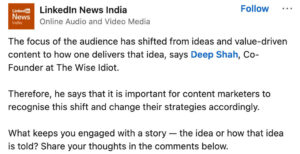When thinking about ‘what does a thought leader mean?’, what are the first few things that come to your mind? Perhaps someone who leads people’s thoughts or someone people rely on for information. That is the case when you broadly look at it.
Thought leaders seek to establish a reputation as an expert and authoritative source. You need to share information in a unique way that solves problems and offers fresh perspectives, making the audience look up to you for more. Consider it like being that best friend people can turn to when in need of good advice. Here, fintech solutions.
Fintech marketing helps share these solutions with a larger audience. When you consistently provide valuable insights, people see you as a reliable source of information. This can lead to increased brand loyalty and customer trust. It is discussed further in the blog.
As an individual or a company, becoming a credible source offering solutions to real problems can increase your influence in the fintech industry and generate valuable financial leads. Another advantage of producing thought leadership content is attracting the attention of other thought leaders in the field. This gives you access to better collaboration opportunities.
To sum up the importance of creating thought leadership content:
- Better reach and generating leads
- Better opportunities to work with other experts
- Establishing trust and credibility
Becoming Good Thought Leaders: The Start
To become good thought leaders, it is essential first to understand the difference between thought leadership and content marketing. Simply, content marketing aims to produce content to communicate a message and expand audience reach and brand awareness, while thought leadership narrows the focus to providing effective solutions for real-life problems in a specialised category.
As an article from the New York Times states, “Thought leadership content is insightful, compelling content meant to pique interest in your company.”
Moreover, no one becomes an expert overnight. To be recognized as a leader, you must consistently showcase your expertise, skills, and experience using content and conversation. Thus, thought leadership is an earned strategy achieved by your active efforts.
Coming to the qualities of a good thought leader, here are some requirements:
- Unique Voice: To avoid getting lost in the crowd of shared knowledge, leaders should have their originality of thought and a way of using that information to tackle problems. To get a better, let’s look at what Adam Grant has to say,
“Creating knowledge without sharing it is elitism.
Sharing knowledge without creating it is marketing.
Creating knowledge for the purpose of sharing it is thought leadership.”
- Expertise: If you have thought leadership as a fintech marketing objective, you must rise above the general topics. Focus on your specialisation and take the extra step to be exceptionally aware of your niche and be in touch with the ongoing trends.
- Consistency: A thing done well once or twice is less reliable than a regular occurrence. More than making your presence known in the landscape, you should maintain it.
- Good communication: An idea or solution is only worth it when it is received and understood successfully. Thus, good communication from the thought leader’s end is essential.
Linking to what you, as a part of thought leadership, should make of these are some of the following approaches.
Firstly, find what separates you from the crowd of fintech marketers.
- Identify Your Niche: Determine your specific area of expertise within the fintech industry. What topics or issues are you most passionate about and knowledgeable about? Is it stock trading, cybersecurity, financial transactions, or something else?
- Stay Informed: Before you guide others, you should have a clear vision of what you know to ensure the reliability of what you convey. Continuously update yourself on fintech trends, innovations, and challenges. Being well-informed is essential for providing valuable insights.
- Create Valuable Content: Share your knowledge and insights through content like LinkedIn posts, whitepapers, videos, or podcasts. Focus on providing solutions, answering questions, and offering a fresh perspective.
- Engage with Your Audience: Actively participate in conversations within the fintech community. With this, you can get an idea of what is happening in the industry, what people are thinking about and their doubts.
- Networking: Build relationships with other professionals in your industry. Collaborate on projects, attend industry events, and connect with peers to expand your reach.
Moving on to a foundation question for good thought leadership – is it needed in the Fintech Industry?
If you think about it, Fintech is a complex field involving technology, finance, and regulation. As a thought leader, you can simplify the terms and solutions to guide the audience in and out of the industry.
Since Fintech itself is a field relying on innovation, thought leaders drive this innovation by introducing new ideas and solutions to solve real-world problems. And with proven results, they earn the trust and credibility of the audience, which is essential in generating financial leads.
Combining Thought Leadership with Content
Now that you have an idea of what thought leadership is all about, it is time to understand how you can effectively communicate it. Before getting into the framework, it is important to lay out the plans.
As mentioned above, you should define your niche in Fintech and establish your unique presence. Your experience, perspective, and interaction with other experts frame the originality of your voice. As you create content to help your audience, make sure to let those aspects shine.
On the a16z podcast, Horowitz explains it this way: “You did something in your past to solve a hard problem and learned something about the world that not a lot of other people know.”
Even taking inspiration from others can work wonders when you add your fresh perspective to it.
Once you have defined your expertise in a certain category, it is time to start with research. Here, your first step, essential for any form of communication, is understanding the audience’s needs.
You can create effective thought leadership content when you align your topics with your audience’s pain points, questions, and challenges.
- Engage in Active Listening: When you want to understand your audience, one of the best ways to do so is to listen to them – their topics of conversation.
- Conduct Market Research: You should also go through industry reports, case studies, and previous surveys related to fintech to get an idea of what the audience engages in and what more information is required.
- Competitor Analysis: Similarly, by engaging with content by competitors, you can identify gaps you can fill with your expertise.
- Trend Analysis: To give the audience the best solutions, you must keep up with upcoming regulations, emerging technologies, and market shifts.
- Feedback Loops: Improvement is the way forward, and to do that, you must encourage feedback. It could be through comments on your posts, surveys, or direct conversation.
- Address Pain Points – Among the things you can do to break down the complexities of fintech, it is necessary to address the real problems people face. But why?
When you share solutions based on a real problem, the audience can see your experience and believe in your ideas, understanding that they work. Moreover, by tackling real problems, you position yourself as a problem solver, which can attract a loyal and engaged following.
Importance of research and content strategy
As a leader, you must be sure the information you convey to your audience is right and rooted in correct contextual data. To do that, extensive research is necessary. Another aspect you should remember during research is defining key performance indicators or KPIs.
These factors also help you prepare your content strategy and ensure it aligns with the objectives of your content. You can accordingly plan your ideas into comprehensive, engaging material for the audience. At a later stage, KPIs and metrics allow you to track the objectives you are achieving and have yet to improve.
Remember that your fintech marketing strategies must be revised frequently in an evolving industry. It is another reason for your viewers to look up to you – their interest in the trend changes.
Incorporating Visuals and Multimedia for Impact
The foremost reason for adding media and visual effects remains to engage the audience through eye-catching visual aids. However, in industries like fintech, concepts can be intricate, flow charts and graphs can be powerful tools to clarify complex ideas.
Another tone of any fintech marketing communication is intertwined with compelling storytelling. Similarly, infographics and videos can provide a dynamic way to convey narratives and make your thought leadership content more impactful.
Thought Leadership Content Framework
It is now time to get to the main framework! Looking at it, you’ll realise the framework is just connecting the dots of the approach, research and communicating them effectively.
- Find your niche – it could be anything from stock trading to cybersecurity
- Conduct research – market trends, competitor analysis, surveys, etc
- Understand the audience’s needs – their pain points, doubts and interests
- Form a content strategy – consider the target audience, sharing platform, and form of content. Plan a calendar to make it handy.
- Create and post valuable content – LinkedIn posts, whitepapers, videos, podcasts, etc.
- Build trust – Be consistent, showcase originality and leverage experience as an advantage.
- Engage with the audience – Be in touch with their needs and questions
- Encourage feedback and work on it
- Grow!
Distribution of Content

Exploring Various Means of Content Distribution
LinkedIn Posts: Right in the center of a platform filled with industry professionals and leaders is where your content has the potential to reach an engaged audience. It allows you to share insights, connect with industry professionals, and participate in relevant groups and discussions, showcasing your expertise. These activities contribute to lead generation for financial services.
YouTube Videos: With engaging visuals, compelling storytelling, and apt communication of solutions, video content for YouTube can be great for fintech trends, case studies, or interviews.
Podcasts: When the conversation turns two-way with experts and leaders on both ends, the audience knows they will benefit. Thus, hosting or participating in podcasts is an effective way to share in-depth insights. You also get to delve deeper into complex fintech topics.
Whitepapers: Another popular way to share expert advice is by developing whitepapers comprehensively exploring complex fintech subjects.
Role of Search Engine Optimization:
The contribution of search engine optimization in thought leadership plays an important role in generating financial leads. It helps search engines like Google, Yahoo, and Bing crawl your content posts, ranking them accordingly to be accessible to users. This can be done by:
– Providing good-quality content
– Using relevant and popular keywords users have been looking for
– Building quality backlinks to your content to ensure credibility.
Building Relationships with Industry Influencers
As you take a step in building relations with other experts in the industry, it is usually a question about how to reach out. The easiest way is to comment on their posts, share your insights, and establish a genuine connection.
You can also initiate collaboration with industry influencers to showcase good thought leadership. It could include co-authoring articles, organising webinars, or engaging in panel discussions. Such collaborations expose you to a broader audience.
As you make your presence known, authoritative sources can also feature you. These features could act as a stamp of expertise for you. Take this post by LinkedIn News India as an example. It features Deep Shah, Co-founder at The Wise Idiot, by attaching his post on tackling the shift of attention of the audience.

Final Thoughts
The recipe for a good dish is a good framework for thought leadership content. The audience is waiting for a guide to have a taste of these. A fintech marketing agency can effectively convey your expert opinions in a way that engages the audience and boosts your presence in the industry.
Our team at The Wise Idiot is composed of passionate writers and designers to craft your thought leadership content in the best way, making good things better for you.
You can check out our previous works on our website to learn more about our thought leadership content creation services and schedule a call today!
Frequently Asked Questions (FAQs)
- What is the difference between content marketing and thought leadership?
Content marketing focuses on promoting a brand through content to drive traffic and conversions, and thought leadership goes a step further. It focuses on offering deep insights, solving industry-specific problems, and establishing the creator as a reliable, authoritative voice in the field. - Why is thought leadership important in fintech?
Fintech is a fast-evolving industry that blends complex technology with financial solutions. With thought leadership, you simplify these complexities, build trust among consumers, and position yourself or your company as a go-to expert. It eventually drives influence and high-quality leads.
- How often should I post thought leadership content?
Consistency is more important than frequency. Aim for at least one high-value post per week, depending on your capacity and platform.
- What platforms are best for distributing fintech thought leadership content?
LinkedIn is ideal for reaching fintech professionals. Supplement that with whitepapers for depth, YouTube for visual storytelling, and podcasts for deeper conversations. Your blog and email newsletters also work well for owned audience engagement.










